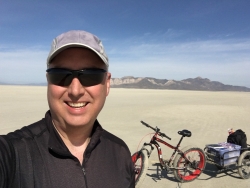Department of Atmospheric Sciences
University of Utah
Bio:
Dr. Perry is an Associate Professor in the Department of Atmospheric Sciences at the University of Utah and has served as Chair of the Department since 2011. He holds a B.S. degree in meteorology from Iowa State University and a Ph.D. degree in Atmospheric Sciences from the University of Washington. He has more than 20 years of management and research experience in the areas of ambient air quality monitoring, analytical technique development, source apportionment, atmospheric dry deposition, and the climatic and health effects of particulate matter. He has participated in more than 20 ambient air monitoring projects ranging from local-scale pollution events to the intercontinental transport of pollutants. For the last year and a half, Dr. Perry has focused his attention on dust plumes originating from the exposed portions of the Great Salt Lake lakebed.
Title: Source Regions and Elemental Composition of PM10 Mineral Dust Originating from the Exposed Lakebed of the Great Salt Lake
Thursday, May 10th, 1:45 PM
Abstract: As the water level of the Great Salt Lake (GSL) has decreased to historic lows, it has exposed more than 550 mi2 of lakebed. Similar to other receding lakes in arid regions (e.g., the Salton Sea and Owens (dry) Lake), the exposed GSL lakebed has begun to generate dust plumes during high-wind events. These dust plumes significantly reduce local visibility and elevate the PM10 and PM2.5 concentrations in communities along the Wasatch Front. A two-year study is currently underway to learn more about how these dust plumes are generated and to what extent they might impact local air quality. Previous studies of the GSL dust have deployed active or passive air samplers at strategic locations and waited for plumes to arrive. This study takes an alternative approach by collecting soil samples directly from the exposed lakebed and returning them the lab for processing.
An Incremental Sampling Methodology (ISM) approach is used to collect composited soil samples from 40-60 individual samples within 4km x 4km gridded cells on the lakebed. Soil samples are collected from both the surface (i.e., top 1 cm) and subsurface (i.e, 1-4 cm). Detailed observations of the soil, including surface crust conditions, are also made at each sampling location. The composited soil samples are then dried, sieved, and resuspended in the lab. PM10 samples are collected onto Teflon filters during the resuspension process for subsequent elemental analysis using Inductively-Coupled Plasma Mass Spectrometry (ICP-MS) and Synchrotron X-ray Fluorescence (S-XRF). Together, ICP-MS and SXRF analysis quantified the following 51 elements in each of the resuspended PM10 samples (Ag, Al, As, B, Ba, Be, Br, Ca, Cd, Ce, Cl, Co, Cr, Cs, Cu, Dy, Er, Eu, Fe, Gd, Ho, K, La, Li, Lu, Mg, Mn, Mo, Na, Nd, Ni, P, Pb, Pr, Rb, S, Sb, Sc, Se, Si, Sm, Sr, Tb, Th, Ti, Tl, U, V, Y, Yb, Zn).
To date, soil from more than 2/3 of the GSL lakebed has been sampled and processed in the lab. The sieving analysis showed that the fraction of #200 mesh particles (i.e., Dp < 75 μm) in the surface soils varied from > 15% near the eastern shore of Farmington Bay to < 1% along the northern shore of Antelope Island and the southern shore of Gilbert Bay. In situ observations of the soil revealed that ~16% of the exposed lakebed is capable of acting as dust source regions (i.e., able to generate visible dust plumes if disturbed). However, almost half of these potential dust hotspots are covered with sparse vegetation or have a non-eroding surface crust which minimizes the probability of dust emission. Thus, less than 10% of the exposed lakebed likely generates dust plumes during high wind events. The locations of these active dust hotspots will eventually be combined with a digital elevation model to determine the relationship between the lake elevation and the number of active dust hotspots.
The chemical analysis shows that the PM10 mass from the resuspended soil samples is dominated by evaporates (e.g., Na, Mg, Ca, K) and high-abundance crustal elements (i.e., Al, Si, Fe, Mn, and Ti). In addition, it revealed significant spatial gradients (i.e., up to a factor of 10) in some of the trace elements. Arsenic is the only element with concentrations greater than both the Residential and Industrial Regional Screening Levels (RSLs) established by the U.S. Environmental Protection Agency to protect human health. Lithium, copper, vanadium, and antimony were found to exceed the RSLs for Residential but not Industrial exposure. All other elements tested were below the RSLs for Residential Exposure. Further analysis should be conducted to determine site-specific RSLs for As, Li, Cu, V, and Sb to determine if they pose a health hazard to the public using more realistic exposure estimates.

